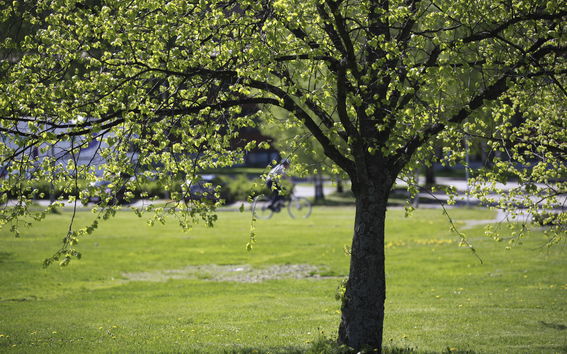Trees, plants and soil could help cities cut their carbon footprints — but mainstreaming their use requires better data

Cities and nations around the globe are shooting for carbon neutrality, with some experts already talking about the need to ultimately reach carbon negativity. In construction, carbon footprint declarations are used to ease product selection for low carbon building, but these standards don’t yet exist for green elements like soil, bushes and plants. A new study led by Aalto University is the first to map out how green infrastructure can be a resource for cities on the path to carbon neutrality.
The study, done in collaboration with the Natural Resources Institute Finland (Luke) and the University of Helsinki, charted out the lifecycle phases of plants, soils and mulches to determine the basic considerations needed to create standards for products commonly used in green urban spaces.
‘Green infrastructure is a building block of cities, yet its products haven’t yet been systematically assessed for their carbon storage potential. We’re now starting to better understand the great importance of these nature-based solutions. Standards for these commonly used products would help us not only better plan our cities, but also help us reach carbon neutrality,’ says Matti Kuittinen, an adjunct professor at Aalto University.
In their study, the team identified the existing carbon footprint standards, widely used in the construction industry, that would need development if applied to green infrastructure. To do so, they compared the flows of carbon in soils, mulches and plants over their lifespans. The team then tried to translate these carbon flows into the standardised reporting format used for conventional building products.
‘One of the main challenges in assessing the carbon storage potential of plants is that the product you buy changes over time. If you install 50 bricks in a building and remove them in a decade, you still have 50 bricks. If you plant 20 seedlings, in ten years’ time you might have 30 large bushes thanks to growth and spread,’ explains Kuittinen.
The recommendations made in the study provide a concrete basis for developing global and regional — for example, European Union — standards for green infrastructure. The aim is to ensure claims of carbon storage hold true, as well as eventually have a tool for landscape designers to help plan new areas or refurbishing existing urban spaces.
The recommendations are particularly relevant for countries and regions like the Nordics, where nature has been traditionally integrated into urban landscapes. However, they can also help other areas meet their carbon targets.
‘Cities need to take all kinds of actions to reach carbon neutrality. The benefit of green infrastructure is that once we know its carbon footprint, it doesn’t require new, expensive technology; it’s a simple, wide-reaching solution that can make real impact. This is an area that needs real attention from decision-makers in the European Union and elsewhere,’ says Kuittinen.
Researchers at Aalto University, together with consortium partners of the Co-Carbon project, are currently starting field tests to determine the exact carbon sequestration potential of plants at various stages of growth. While the carbon storage potential of trees is relatively well-known, the study is set to be the first to focus on plants and bushes, elements commonly used in urban landscaping. At Luke, researchers are developing a tool to model the changes in carbon storage of plants and soil at regional level due to land use changes. Such a tool could help planners target and maintain existing carbon storage in plants and soil.
The open-access study is published in the International Journal of Life Cycle Assessment.
More information
Dr. Matti Kuittinen
Adjunct Professor
Aalto University
matti.kuittinen@aalto.fi
+358505947990
Dr. Eeva-Maria Tuhkanen
Research scientist
Natural Resources Institute Finland
eeva-maria.tuhkanen@luke.fi
+358295326595
Read more news

Your voice gives away valuable personal information, so how do you keep that data safe?
With speech technologies becoming increasingly common, researchers want to make sure we don’t give away more information than we mean to.
Aalto in 2025: Quantum leaps, creative breakthroughs and solutions for a better life
Growth, technology and industrial renewal; human-centred solutions; health and everyday wellbeing; and enjoyable daily life and thriving communities.
Research Council of Finland establishes a Center of Excellence in Quantum Materials
The Centre, called QMAT, creates new materials to power the quantum technology of coming decades.






